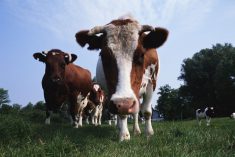CNS Canada — Expansion efforts in Canada’s cattle sector are likely taking a breather right now, as a lack of rain in Alberta and Saskatchewan creates challenges for ranchers trying to feed their animals.
According to Anne Wasko of Gateway Livestock Inc. at Taber, Alta., some cattle in the western Prairies are already being moved off grass.
“We’ve seen early marketing of cow-calf pairs coming to market; higher feed costs are at the forefront of their considerations,” she said.
If rain doesn’t come soon, she said, yearling cattle could also be going on feed in July, instead of August and September.
Read Also

U.S. grains: Soy futures set 15-month high after China agrees to purchases
U.S. soybean futures reached a 15-month high on Thursday after President Donald Trump’s administration said top-importer China agreed to buy tens of millions of tons of American crops in the next few years as part of a trade truce.
“It means moving that marketing window forward.”
While there haven’t been any mass sell-offs yet, a recent report out of Chicago indicated some U.S. analysts expect sales of Canadian cattle to pick up as a result of the dryness.
Wasko acknowledged many producers are plotting the best way forward.
“I suspect producers are out looking at options right now. If they’re in an area where grain crops have been impacted because of the drought, maybe there is a way of working with those grain producers to access some feed?”
The situation is undoubtedly frustrating for ranchers who had planned to expand their herds, she said.
“They’re looking to speed that up. But winter feed costs and dry conditions could slow that expansion down.”
Despite the turmoil, Wasko said the market is relatively the same as it was a few weeks ago — but that could change once things pick up in August.
According to numbers from Canfax, Canadian cattle inventories on Jan. 1, 2015 were down 2.5 per cent on the year at 11.9 million head, the smallest such level since 1993.
In contrast, the U.S. cattle herd has been on the upswing, with inventories rising 1.4 per cent to 89.8 million head during that same time frame.
— Dave Sims writes for Commodity News Service Canada, a Winnipeg company specializing in grain and commodity market reporting.










